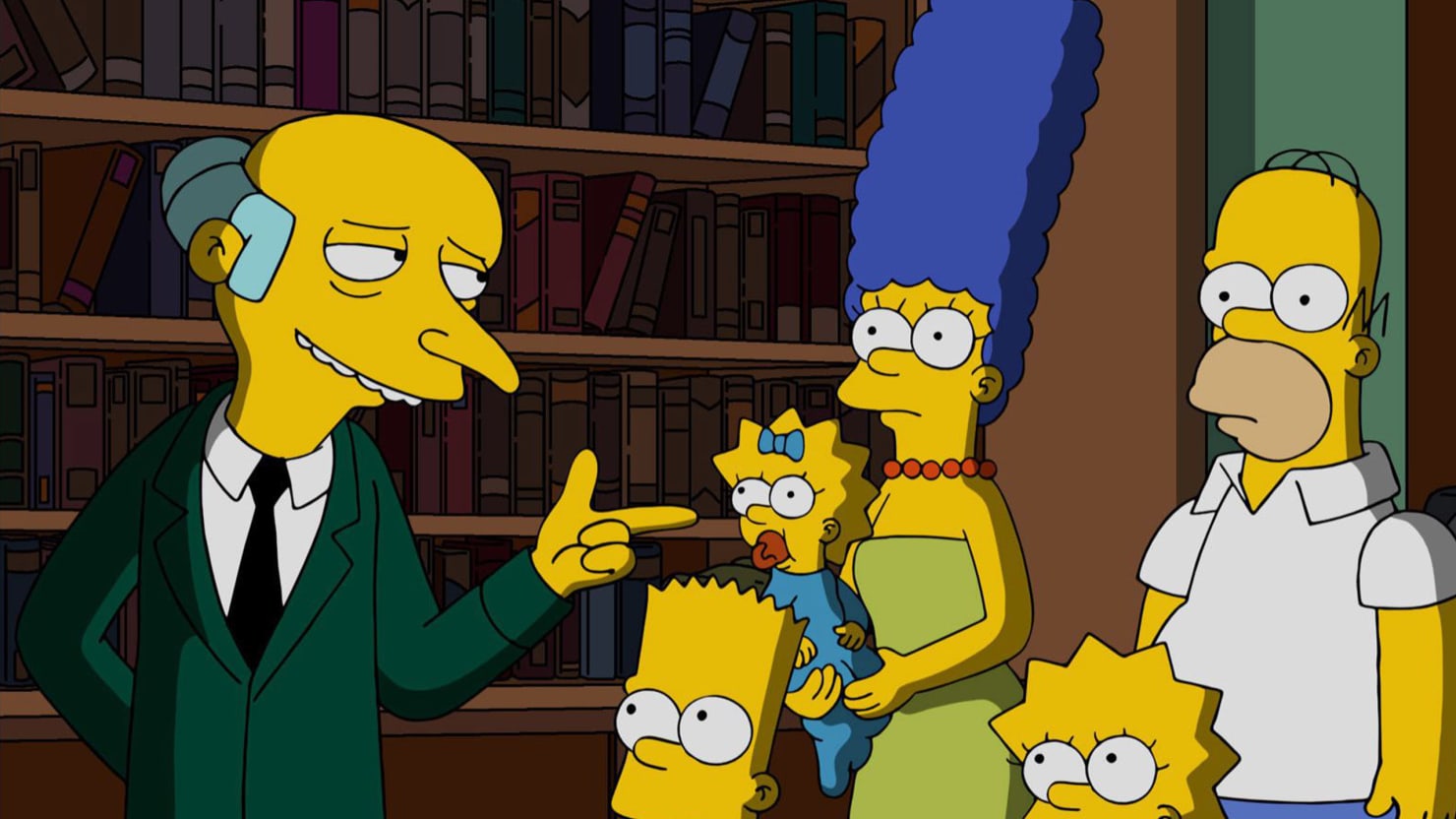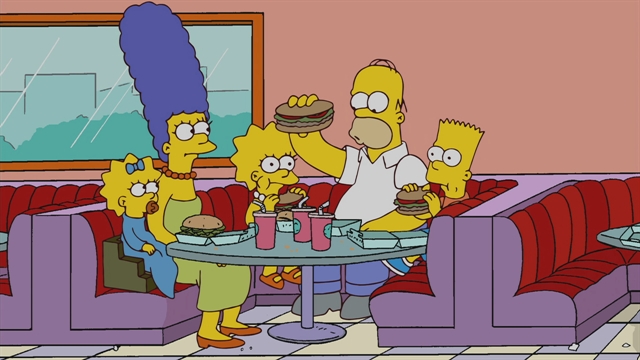How Social Class is Portrayed in The Simpsons

In a 1995 episode of The Simpsons, Homer walks with Marge
along a downtown sidewalk. He tells Marge to be careful because the streets are
dangerous for “us upper-lower-middle-class types." Although this is the
first time in the series where Homer admits he is a member of the middle class,
this is no surprise for many viewers. After all, the
Simpson family lives in a decent house in the suburbs, and Homer has a job which
does not require much skill. Furthermore, there are many characters which live
higher lifestyles than him, and other figures exist who have lower social
standings. Through analyzing how class is portrayed in The Simpsons, it can be concluded that the show views the upper class at the best place to be, although getting there may be challenging and lead to a lifestyle filled with negative connotations.
Cletus Spluckler is one of the characters in The Simpsons
who is a member of the lower class. He is a hillbilly who is often seen dressed
in blue jeans and a singlet. He is the father of several children who wear
worn-out clothes which do not properly fit. This is an indicator of Cletus
being a member of the lower class because it shows that he cannot afford decent
clothing for his offspring.

Cletus also has low intelligence, which is another
sign of having a low social standing. This is, however, believed to be the
effect of inbreeding or mercury poisoning. When speaking, Cletus and his family
often disregard proper grammar and use slang. Because this is a rather sloppy
manner of speaking, these characters are regarded as uneducated members of the
lower class who are not very sophisticated.
Homer,
while a member of the middle class, still exhibits some traits which make him
seem uneducated and poor. He is usually lazy and speaks in a casual manner. His
main job is a nuclear safety inspector, which appears to be very simple
considering the amount of time he often spends relaxing in his office or conversing with
coworkers in various episodes. Furthermore, Homer drives an economy car with a
dented fender and drinks frequently. Both of these actions are commonly done by
members of the lower and middle classes. Other aspects of his lifestyle further
enforce the idea that Homer is a member of the middle class. Homer and his family live in a
modest house in the suburbs and often consume fast food from restaurants such
as Krusty Burger.

In addition, Homer tends to complain about his job and wish
he had a more prestigious and high-paying occupation. Although Homer’s life is
somewhat better than that of Cletus and other members of the lower-class, it is
still clear that the middle class is viewed as undesirable in The Simpsons.
While
the series may portray members of the upper class as well-educated elites who have
better lifestyles than others, it also depicts them as dubious individuals with
malicious intentions. Sideshow Bob, for example, speaks in a very sophisticated
manner and properly pronounces each word he says. Some episodes even feature
him speaking in other languages, including French, Spanish, and Old Scottish.
The suggests that Bob knows had an exceptional education when growing up, which
is common of members of the upper class. It should be noted, however, that
Sideshow does act in malevolent ways throughout the series. In season one he
tries to frame Krusty the Clown for an armed robbery, and in later seasons he
tries to kill Bart as revenge for Bart discovering the truth about the incident in
question.
This suggests that although he is an intelligent member of the
elites, he prefers to use his knowledge for evil rather than good. A similar
case about upper-class individuals abusing their power can be made about Mr.
Burns. Despite being a very wealthy and successful businessman, Burns treats
his employees poorly. He has cut the dental plans of his employees and ignored
worker safety regulations. Furthermore, in one episode Burns hits Bart with his
car and refuses to care about the boy’s health.
He later tries to offer Homer
one hundred dollars to make up for the incident, which disgusts Homer. This
again proves that although those in the upper class may have an education and
money, they are made to look like terrible people. Although The Simpsons depicts the upper class as
a better place to be than the lower classes, it suggests that being there also
comes with a fair share of corruption and deceit.
Although
being in the upper class is desired by most characters, getting into this niche
is very difficult. Vox analysts compiled a list of the dozens of jobs which Homer had over
the course of the show’s first twenty-seven seasons. Nearly half of these
occupations are taken by members of the middle class, where Homer belongs for
most of the program’s run. When the salaries for each of Homer’s jobs were
studied, it was revealed that his median salary was approximately forty
thousand dollars. While this is more than what he makes during his usual job as
a safety inspector, this salary still places him comfortably in the middle class. When
these salaries were graphed over the course of the series, it was determined
that Homer never really advances in social standing despite what job he gets.
:no_upscale()/cdn.vox-cdn.com/uploads/chorus_asset/file/7050097/jobs-over-time2.0.png)
Even though some episodes involve him working in jobs which are worth hundreds
of thousands of dollars per year, such as a company executive and a union
leader, Homer always manages to fall back to having a job which places him in
the middle class. This suggests that although those in Springfield may be able
to prosper in the workforce, they will soon resume being a member of their original social class. Through analyzing Homer’s jobs over the show’s run, it can be determined
that although having a higher social standing may be desired by many
characters, obtaining such a position for long is very challenging.
Although
The Simpsons poorly portrays the
lower and middle classes, it makes the upper class seem like a place for
corrupt people. Despite members of the upper class being well-educated and
wealthy individuals, they are also associated with crime and greed. The upper
class is still desired over the lower classes, however, for the increased
money, respect, and standing those in this group have. Unfortunately Homer’s
experience working various jobs has proven that although becoming an elite in
Springfield is possible, staying there for a while is a challenge. Although
class may be an issue which divides those in Springfield, it also provides
people with different backgrounds to impact who they are, making the show more
interesting. Although the presence of social classes in The Simpsons may improve the show, it also permanently affects the
lives of most of the characters.
Sources:
Crockett, Zachary. "What Homer Simpson's 100+ jobs tell us about America's middle class," Vox, 16 Sep. 2016. https://www.vox.com/2016/9/6/12752476/the-simpsons-homer-middle-class
Eckman, Moses. "Are These the 3 Worst Things Mr. Burns Has Ever Done?," WatchMojo.com, 7 Sep. 2018. https://www.watchmojo.com/blog/2018/09/07/are-these-the-3-worst-things-mr-burns-has-ever-done
Peterrson, Jessica. "Social Class in the Simpsons," University of Gothenburg, 2010. Retrieved from https://gupea.ub.gu.se
The Simpsons: The Complete First Season. Created by Matt Groening, Twentieth Century Fox, 1989-1990.
No comments:
Post a Comment